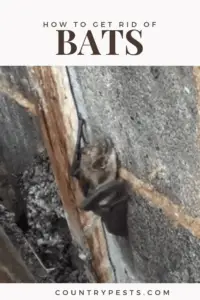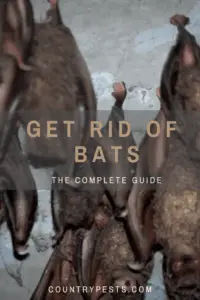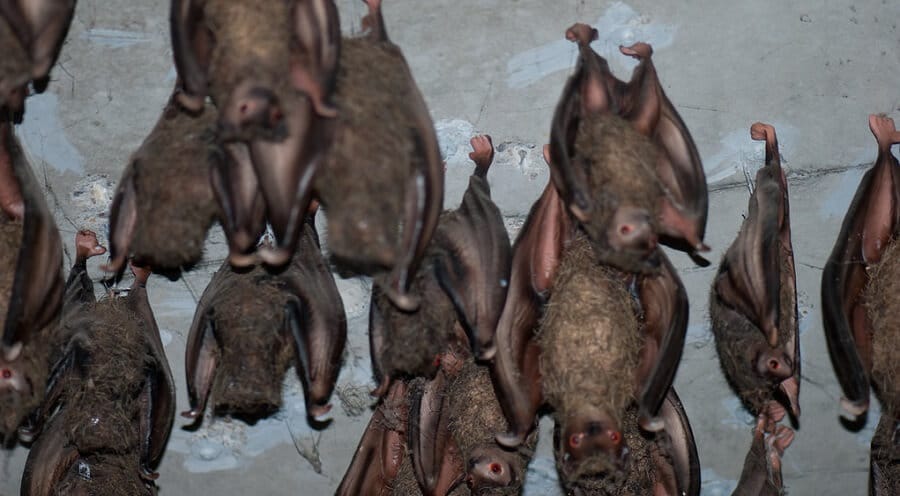Most people don’t like bats and would rather keep them away. Bats are found in most places. This means that bats may live on your property, be found in your attic, or hang out under your porch eaves. If you want to keep bats away, your approach will vary, depending on where the bats are congregating. This article will cover these main points.
How To Keep Bats Away From A Specific Area
How To Get Bats Out Of My Attic
In addition to the steps mentioned in this article, there are specific steps that you can take to eliminate bats from your house. Often bats will live in an attic for a long time before they are discovered. This means that simple decoy and other devices are not usually effective. The attic has already become much too appealing to the bat colony.
There is no 1-step or simple way to eliminate bats out of your attic. It will take a period of time and several steps to be effective.
1. Locate All Entrance Points To Your House
Be aware that bats can enter an area in a space as small as a quarter. ⅜ of an inch is all it takes for a bat to crawl in. They love long narrow spaces because it offers them great protection. They also love to enter vía small entryways because predators can’t follow them.
That often means that the most obvious entrances are not the ones that bats use the most. It also means that the entrances that bats use may be difficult to locate.
To find where bats are going in and out, watch your house. You will need to have enough people located around the perimeter to watch the entire house.
Surround the house at dusk. Bats become active at ducks and will start leaving the attic in search of food. Bats will almost always leave within an hour of darkness. Usually within the first half-hour.
The exit points can be as small as your thumb. Take notes, if there are a lot of places where bats exit the house.
Did you know?
Bat’s don’t need to eat nightly. They can often skip a night’s meal. That means that you should watch your house for bat entrances several evenings in a row.
This step will probably need to be repeated as you seal and eliminate various exits from bats.
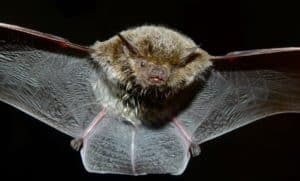
2. Set Up A Bat House Near The Main Entrance-Exit Point
The purpose of a bat house is to provide an alternative and safe place for the bats to roost. Bats are incredibly helpful to the local ecology and they keep insect populations greatly reduced. But, because of human encroachment into the wild, bats have become increasingly endangered. They are protected in most areas.
A bat house allows you to keep the benefits of the bats in your area and on your property without placing the bats at unnecessary risk or danger.
3. Seal All Small Entrance Points, Leaving Main Exit Point Open
Some professionals recommend sealing the entrance points during the night time. This blocks off the main entrances while bats are out hunting for bugs and keeps them from returning. However, because of the darkness, it can be harder to effectively seal bat entrances at night. It is also more inconvenient for most people.
You can also seal the entrance gaps and holes during the day. A daylight inspection makes it easier to find small areas that bats can enter an attic.
Be aware
Bats can enter very small spaces. They can hide in small nooks and crevices. Long linear gaps along a roofline can become an ideal place for bats to hide. Even holes as small as a quarter can allow bats into an attic.
This can make sealing an older home more difficult because of the many gaps that often exist in construction.
Leave at least 1 major exit point available for the bats while you seal the other exits. This allows subsequent bats to leave your house. We will cover how to seal the main exit areas with a one-way door in the next section.
- Don’t seal all exits at the same time or it may trap bats inside your house
- Bat’s don’t leave every night to eat. Some bats may stay indoors on a specific night.
- Be aware that bats like small entrances
- A bat can enter any space that’s as wide as ⅜ of an inch.
Take the time to calk or seal all small holes. Different types of construction can present different problems.
Tile Roofs: Often provide many gaps and areas for bats to hide. It is necessary to either calk and to seal off all the places of entry or to install netting over the roof to prevent bats from entering.
Chimneys: Usually have many entry points where cracks and holes exist. The dampener can be installed using a one-way door that will allow bats out, but not in. Additional holes in the chimney must also be sealed. Do not start a fire with bats in the chimney. It can cause them to fly into the house and can kill them. Make sure the bats have left your chimney first.
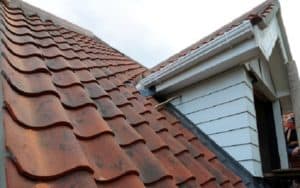
4. Set Up A One-way Door Over Bat Exits
A one-way door allows the bats in your house to leave, but not to return. There are several ways to set up a one-way exit.
One-Way Exits Using Screen or Netting
The easiest way to do this is to install a screen or hardware cloth over the exit area.
Secure the screen on the top and both sides. Leave a little slack at the bottom where the screen is not secured.
The screen catches bats when they fly out of the house. They then fall down the screen and are able to crawl out. When they return, the screen blocks off the entrance. Bat’s are unable to figure out how to crawl up the screen to get back into your attic.
Stealth netting can be secured over tile roofs and other roofs with a lot of entrance points. This allows bats to exit the roof and make their way out without allowing them back in through the tiles.
One-Way Exits For Round Holes
If the main entry point is a round hole, then you can create a one-way exit with a PVC pipe. Install the size of pipe that will fit snugly in the hole. Use calking if you need to seal around the PVC.
Make the interior part of the pipe flush with your inside wall. This will allow the bats to continue to exit through the hole.
The outside of the pipe should extend out from your house for about a foot. This will make it difficult for the bats to enter, but not to leave your home.

5. Monitor Bat Activity For A Week
Check your attic and watch your house for the next week. Watch for signs of further bats. Watch to see if there are other areas that bats are entering or exiting the home that you were previously unaware of.
Monitor your home and to seal and fix the exit points where bats are accessing your home. Continue this as long as you see bat activity around your home. Check for other signs of bats around your house, on your siding, and along your roof.
6. Double Check For Remaining Bats And Babies
Once the bat activity has stopped, you will need to make sure there are no remaining bats in your home. Wait until you are confident that you have sealed or added a 1-way door to all the exits around your home.
Make sure to check all the crevices and corner of your attic. You will need a strong flashlight. You can also use a GoPro and a selfie stick or other camera to reach into hard-to-reach areas. Those are the areas that bats love the best so don’t do a casual check of your attic.
- Use masks and gloves to check for bats
- Use a bright flashlight to check crevices and small spaces
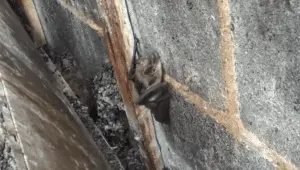
7. Clean Up All Signs Of Bat Activity
Bat guano smells and is pretty corrosive. It can eat into wood and other materials in a house. It also stinks. When it is breathed in, it causes flu-like symptoms to people, especially the young and elderly.
In addition, some bats can carry disease and illnesses that can be passed to people. Make sure that when you clean up all bat activity that you wear protective gear. This will help you avoid getting sick
8. Permanently Seal Remaining Exit Points
Continue to watch your attic for any further bat activity including defecation. Once you have determined that there are no further signs of bats, seal the last remaining exits. Instead of leaving 1-way doors installed, permanently seal them by securing the netting on all sides or using sealant.
This will help to prevent future entrance of bats. Be sure to check netting or screens placed over vents annually to make sure that holes don’t wear into them and allow future access to bats.
How Do I Know If Bats Are In My Attic?
Bats usually live in people’s attics for a long time before they are discovered. This is because bats are generally very quiet, even in large numbers. Often a single bat will escape or be lured into the living space of a home.
The homeowner may think they have an isolated case of a bat coming in and not even realize that there are dozens of bats in his attic.
Because bats are nocturnal, they are almost always completely silent during the daytime hours. At night, they are still very quiet as they have very sensitive hearing and can navigate around small areas without bumping into things.
- Assume that isolated cases of bats are not isolated and check for additional bats.
- Watch the roof and sides of houses for stains caused by bat fur scraping against the walls
- Watch for bat guano to collect under awnings and other areas with gaps
- Investigate any sounds in the attic, even if they are sporadic or minimal.
Over time, bats will leave a brownish stain of urine and fur by the small crevices they use to get in and out of a house. If you notice a stain appearing along the outside walls of your house, check for gaps and monitor for bats.
Those holes will need to be taken care of.
Plus, bats will often leave guano (poop) in piles where they crawl in and out. These piles of poop on a lower roof or eve will indicate that bats are in the immediate area.
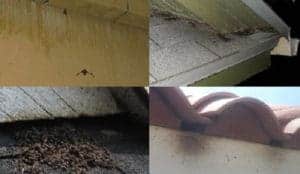
How To Get Rid Of Bats In A Barn
Barns are usually open places and it is difficult to keep bats out of the barn. Sealing the entry points is the only effective way to get them out. Most chemicals and repellents put other animals in danger.
Plus it is illegal in most places to harm bats. Many repellents are also illegal to use on bats. Bats perform a crucial benefit to the local ecosystem. Every bat eats as much as 8,000 bugs a night!
While getting bats out of your house is recommended, keeping bats out of a barn is not. A barn usually provides a safe place away from human living for bats to live. Bats in the barn usually don’t pose any risk to the animals in the barn and will do more help than the potential harm.
How To Keep Bats Away From The Pool
Pools can be an attraction for bats because they like the water. They also like buts and other insects that can be attracted to water. Bats around your pool will keep the mosquito and other bug populations in check. There are a few things that you can do to help bats and people interact better. First, set up some bat houses in the area. Make sure that they are designed well. Some bat houses don’t work well because they are too cramped or not built well enough to keep the bats warm. Secondly, be aware that bats won’t run into people. They are very good at navigating around things. Third, if you have a heavy insect population, consider spraying to kill them. This will eliminate the food attraction for the bats. Fourth, appreciate how much the bats help the population. Bats are rarely a danger to people and they do immense good.
How To Keep Bats From Roosting Under The Eaves
Bats love to hide in small places where they are safe and the eves of a house is ideal for them. If you suspect a bat problem there are several places you should look and signs you should look for.
First, check the cracks and crevices around your house. Look for stains along the walls or piles of droppings. Droppings, or bat guano, can collect high up on part of your roof or an easement of your house.
Second, try switching outdoor lights to a yellow light. This will attract fewer bugs and, in turn, fewer bats.
Third, seal the areas where bats are getting in. This can be a very extensive job. Bats can get in very small areas. Check out this video for how one exterminator was able to get rid of a bat problem.
Here are the places you should check for bats around your house:
- Junctures where the walls meet the eves
- Underneigh roofing tiles or overhangs
- Under loose flashing or boards
- Through poor fitting or torn screens
- Around the holes in the house where pipes enter
- At the juncture where the porch meets the house
- Cracks in the siding where it meets the chimney or forms a corner
Do Bats Have Rabies?
Experts estimate that less than 5% of wild bats have rabies. This means that the vast majority of bats are safe for humans. However, bats can be sick. If you have a bat population around your yard, keep an eye on sickly or flopping bats as that is usually the main sign that you have sick bats.
If you do have sick bats, then seek professional help. There are strict laws in place regarding how bats, even sick ones, can be dealt with and it is important to keep yourself and your family safe.
Bat guano can cause flu-like symptoms in some people. The young and old are more vulnerable to these symptoms. If you clean up bat excrement, then make sure to wear a breathing mask and gloves to avoid contact with it. That will be adequate protection for most healthy adults.
Will Mothballs Keep Bats Away?
In some cases, mothballs may be effective. However, they are usually ineffective and pose various risks to people, other animals, and bats. That’s because, in order for mothballs to be effective against bats, they must be used in high concentrations. A few mothballs in an attic won’t’ be sufficient. You may need as many as 500 or more mothballs in a typical 3/2 house attic. At that high of a concentration, the mothballs will also pose a health hazard to everyone living in the house. Mothballs contain a number of toxic chemicals that are harmful to people and animals and prolonged exposure increases the danger.
Further, bats are a protected species. They are one of the most important animals in the ecosystem and their populations are drastically decreasing. It is illegal to kill them in most of the USA and in many countries around the world. Using mothballs will harm bats and negatively affect the local ecosystem.
Are Bats Blind?
Bats are not blind. They actually have normal eyesight for most animals. Bats can see ultraviolet rays, which helps them to identify certain types of flowers and fruit. So in that sense, bats can see better than people.
But, bats don’t use their eyesight nearly as much as their hearing. Bats navigate and find insects almost completely through their superpower hearing. They bounce sound waves off the things around them and are able to hear how the soundwaves come back.
This creates a map for them that is much more effective than eyesight. Because bats fly at night, this is important for them. After all, how well can you see at night without lights?
Photo credit feature image: Thomas Quine
[post-carousel id=”364″]
